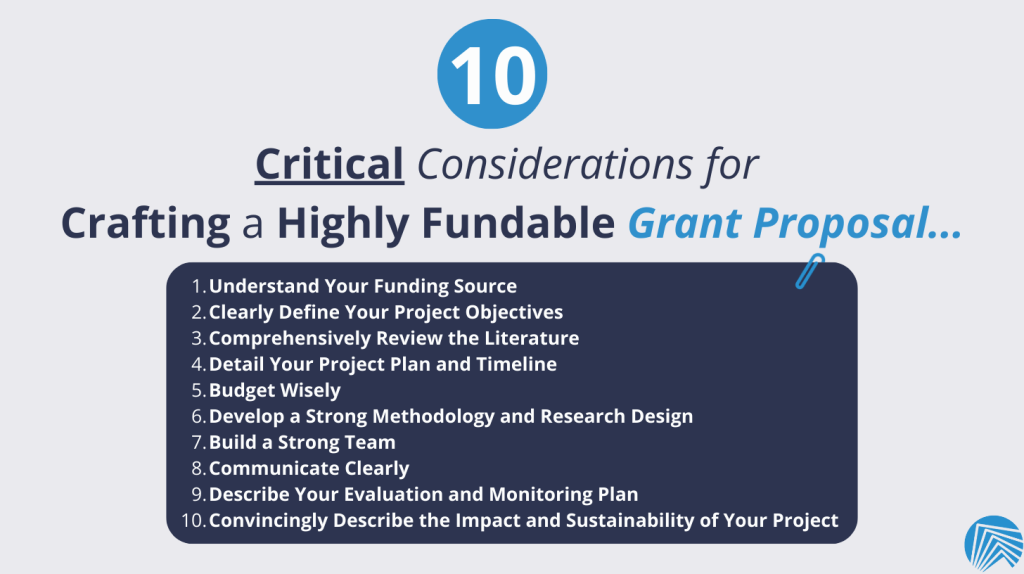Securing funding through grant proposals is a competitive and rigorous process. To increase your chances of success, it’s crucial to craft a highly fundable proposal that effectively communicates your project’s significance, feasibility, and potential impact. Here, we describe 10 critical considerations that can significantly enhance your grant proposal and improve its fundability.
Also Read:
Writing a Concise Science Manuscript in 4 Steps

1. Understand Your Funding Source
Research the grant funder’s mission and priorities
Before you begin writing your grant proposal, thoroughly research the funding organization’s mission, values, and priorities. Understand what types of projects they typically support and the goals they aim to achieve.
Align your project with the funder’s goals
Craft your grant proposal to align seamlessly with the funder’s objectives. Clearly demonstrate how your project directly contributes to their mission and addresses their specific priorities.
Tailor your proposal to fit their requirements
Carefully review the grant application guidelines and requirements provided by the funder. Follow their instructions meticulously, ensuring that your proposal complies with their format, submission guidelines, and deadlines.
2. Clearly Define Your Project Objectives
Define SMART objectives
SMART objectives are Specific, Measurable, Achievable, Relevant, and Time-bound. Clearly articulate what you aim to accomplish with your project, how you will measure success, and the timeframe for achieving these objectives.
Explain expected outcomes and impact
Describe the expected outcomes of your project and how they align with your defined objectives. Highlight the potential impact of your project on the target audience, community, or field.
Demonstrate alignment with broader goals or needs
Explain how your project fits into broader goals or needs within your field. Explain how addressing these goals or needs is critical and how your project is uniquely positioned to make a difference.
3. Comprehensively Review the Literature
Conduct a thorough literature review
Conduct a comprehensive literature review to demonstrate your familiarity with the current state of knowledge in your field. Identify key studies, gaps, and emerging trends relevant to your project.
Identify gaps and unaddressed questions
Highlight gaps or unanswered questions in the existing literature that your project will address. Emphasize the novelty and significance of your approach in filling these gaps.
Highlight the significance of your project
Clearly articulate the significance of your project within the context of existing research. Explain how your work builds upon or challenges previous findings and contributes to the advancement of knowledge.
4. Detail Your Project Plan and Timeline
Present a well-structured project plan
Develop a comprehensive project plan that outlines the major activities, milestones, and tasks required to achieve your objectives. Create a timeline that indicates when each activity will be completed.
Break down tasks, responsibilities, and timelines
Clearly define who is responsible for each task and specify deadlines. This demonstrates that you have a well-organized and realistic approach to project management.
Show a clear path to project completion
The timeline should provide a clear path to project completion within the grant period. Avoid overly ambitious timelines that could raise doubts about feasibility.
5. Budget Wisely
Create a detailed and realistic budget
Develop a detailed budget that accounts for all project expenses, including personnel, equipment, materials, and indirect costs. Ensure that your budget aligns with the scale and scope of your project.
Justify all budget items and expenses
Provide a thorough justification for each budget item, explaining why it is essential for the successful execution of your project. Be transparent and avoid any ambiguities in your budget justification.
Align the budget with your project’s objectives and activities
Ensure that the budget reflects the priorities and activities outlined in your project plan. The funder should see a direct link between the budget and the proposed project.
6. Develop a Strong Methodology and Research Design
Describe your research methods comprehensively
Clearly explain the research methods and techniques you plan to use in your project. Provide a rationale for why these methods are suitable for achieving your objectives.
Explain why your chosen methods are suitable
Highlight the strengths of your chosen methods and how they address potential limitations or challenges in your research. Demonstrate that you have considered alternative methods and explain why you have chosen the proposed approach.
Address potential challenges and provide solutions
Acknowledge any potential challenges or limitations in your research design and methodology. Offer realistic and well-thought-out solutions to mitigate these challenges.
7. Build a Strong Team
Highlight the qualifications and expertise of your team members
Showcase the credentials, qualifications, and relevant expertise of your project team members. Emphasize their contributions to previous successful projects or research.
Showcase their previous work and relevant experience
Provide examples of your team members’ previous work demonstrating their ability to carry out the proposed project effectively. This could include publications, presentations, or successful grant awards.
Emphasize collaboration and synergy within the team
Describe how your team members will collaborate and leverage each other’s strengths to achieve project objectives. Highlight the complementary skills and expertise within the team.
8. Communicate Clearly
Write clearly and concisely
Craft your grant proposal with clarity and conciseness. Avoid overly complex sentences, jargon, or technical language that may obscure your message. Make your proposal accessible to a broad audience.
Avoid jargon and technical language when unnecessary
While it’s essential to convey your expertise, use technical terms and jargon sparingly. Define terms when necessary and ensure that the proposal is understandable to both experts and non-experts.
Proofread and edit your proposal rigorously
Carefully proofread your grant proposal to eliminate grammatical errors, typos, and inconsistencies. Consider seeking feedback from peers, colleagues, or professional science editors to ensure clarity and coherence.
9. Describe Your Evaluation and Monitoring Plan
Develop a robust evaluation plan
Create a comprehensive plan for evaluating the progress and impact of your project. Specify the metrics, indicators, and data collection methods you will use to assess your project’s success.
Describe how you will measure progress and success
Clearly outline how you will measure the achievement of project objectives and outcomes. Explain the criteria you will use to assess the project’s effectiveness.
Explain how you will adapt your project if needed
Anticipate potential challenges or deviations from the initial plan and describe how you will adapt your project to address these issues. This demonstrates your commitment to achieving the project’s goals.
10. Convincingly Describe the Impact and Sustainability of Your Project
Articulate the long-term impact of your project
Clearly state the long-term impact your project aims to achieve. Explain how the project’s outcomes will lead to lasting benefits for the target audience, community, or field.
Discuss how your project will be sustained beyond the grant period
Address the sustainability of your project beyond the grant’s duration. Describe how you plan to secure ongoing funding or resources to maintain and expand the project’s impact.
Show how it aligns with the funders’ and community’s interests
Emphasize how your project aligns with the interests and priorities of the funding organization and the broader community it serves. Highlight the mutual benefits of supporting your project.
Conclusion
Crafting a highly fundable grant proposal requires careful planning, attention to detail, and a persuasive presentation of your research project. By understanding your funding source, clearly defining project objectives, conducting a comprehensive literature review, and addressing each of the ten critical considerations outlined in this guide, you can significantly enhance the quality and fundability of your grant proposal. Remember that a well-crafted proposal not only secures funding but also contributes to the advancement of knowledge and the betterment of society through impactful research and initiatives.
Like this article by SciTechEdit International? See more Useful Articles and our Writing Tips.




